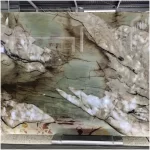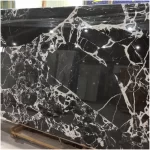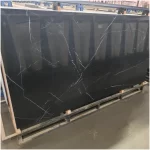What is the difference between marble and granite?
The way to distinguish marble and granite with the naked eye is to look at their patterns. The patterns of marble are varied, the lines are smooth and freehand, and the colors are varied. The granite patterns are all speckled, without obvious patterns, and the colors are generally white, gray, black, red, yellow, etc., which are relatively simple.
1.Granite
Granite is an igneous rock, formed by underground magma ejection and intrusion cooling crystallization, and granitic metamorphic rock. With visible crystal structure and texture. It consists of feldspar (usually potassium feldspar and feldspar) and quartz, mixed with a small amount of mica (biotite or muscovite) and trace minerals, such as: zircon, apatite, magnetite, ilmenite And sashimi and so on. The main component of granite is silica, and its content is about 65%-85%. The chemical properties of granite are weakly acidic. Under normal circumstances, granite is slightly white or gray, due to the dark crystal mixed with speckled appearance, the addition of potassium feldspar makes it red or flesh-colored. Granite is formed by the gradual cooling and crystallization of magma, and it is buried deep below the surface. When the cooling rate is extremely slow, it forms a granite with a very rough texture, which is called crystalline granite. Granite and other crystalline rocks form the basis of the continental plate, and it is also the most common intrusive rock exposed on the surface of the earth.
Blue Pearl Granite Slab
Although granite is considered to be igneous rock formed by melted material or magma, there is a large amount of evidence that some granite formation is local deformation or the product of previous rocks, and they have not been rearranged and recrystallized without undergoing a liquid or melting process. The specific gravity of granite is between 2.63 and 2.75, and its compressive strength is 1,050 to 14,000 kg/cm2 (15,000 to 20,000 psi). Because granite is stronger than sandstone, limestone, and marble, it is more difficult to mine. Due to the special conditions and firm structural characteristics of granite formation, it has the following unique properties:
(1) It has good decorative performance and can be applied to public places and outdoor decoration.
(2) Has excellent processing performance: sawing, cutting, polishing, drilling, carving, etc. Its processing accuracy can reach below 0.5μm, and its luminosity can reach above 1600.
(3) Good wear resistance, 5-10 times higher than cast iron.
(4) The coefficient of thermal expansion is small, and it is not easy to deform. It is similar to indium steel and is minimally affected by temperature.
(5) The modulus of elasticity is large and higher than that of cast iron.
(6) Good rigidity and large internal damping coefficient, 15 times larger than steel. Can be shock-proof and shock-absorbing.
(7) Granite is brittle, and only partially falls off after damage, without affecting the overall straightness.
(8) Granite has stable chemical properties, is not easy to be weathered, and is resistant to acid, alkali and corrosive gases. Its chemical property is proportional to the content of silica, and its service life can reach about 200 years.
(9) Granite is non-conductive and non-magnetic, and the field position is stable.
Generally, granite is divided into three different categories:
Fine-grained granite: The average diameter of feldspar crystals is 1/16~1/8 inch.
Medium-grained granite: The average diameter of feldspar crystals is about 1/4 inch.
Coarse-grained granite: feldspar crystals have an average diameter of about 1/2 inch and larger diameter crystals, and some even reach a few centimeters. The density of coarse-grained granite is relatively low.
In recent years, among the stone materials used in monument buildings, granite accounts for 83% and marble accounts for 17%.
2.Marble
Marble is formed by sedimentary rocks and metamorphic rocks of sedimentary rocks. It is a metamorphic rock formed after the recrystallization of limestone, usually accompanied by the texture of biological remains. The main component is calcium carbonate, its content is about 50%-75%, it is weakly alkaline. Some marbles contain a certain amount of silica, and some do not. The particles are fine (referred to as calcium carbonate), the surface streak distribution is generally more irregular, and the hardness is lower. The composition and structural characteristics of marble make it have the following properties:
(1) Good decorative performance, marble does not contain radiation and is bright and colorful, and is widely used for decoration of indoor walls and floors. Has excellent processing performance: sawing, cutting, polishing, drilling, carving, etc.
(2) The abrasion resistance of marble is good, not easy to aging, and its service life is generally about 50-80 years.
(3) In industry, marble is widely used. Such as: used for raw materials, purification agents, metallurgical solvents, etc.
(4) Marble has the characteristics of non-conductivity, non-magnetic conductivity and stable field position.
White marble slab with fish maw
From a commercial point of view, all naturally occurring calcareous rocks that can be polished are called marbles, as are certain dolomites and serpentines. Because not all marbles are suitable for all architectural occasions, marbles should be divided into four categories: A, B, C, and D. This classification method is particularly suitable for relatively brittle C and D marbles, which require special treatment before or during installation.
The specific classification is as follows:
Class A: high-quality marble, with the same and excellent processing quality, free of impurities and pores.
Type B: The characteristics are close to the former type of marble, but the processing quality is slightly worse than the former; there are natural defects; a small amount of separation, adhesion and filling are required.
Category C: There are some differences in processing quality; defects, pores, and texture fractures are more common. Repairing these differences is moderately difficult, and can be achieved by one or more of the following methods: separation, gluing, filling, or strengthening.
Type D: The characteristics are similar to those of type C marble, but it contains more natural flaws and the largest difference in processing quality. It requires the same method for multiple surface treatments. This type of marble is affected by many colorful stones, and they have good decorative value.
Stone Research Institute (IDstone5A)
The difference of the use range of marble granite
The most obvious difference between granite and marble is that one is used outdoors and the other is used indoors. The patterned natural stones seen indoors are mostly marble, while the spotted natural stones paved on the outdoor pavement are granite.
Why is there such a clear distinction between places?
The reason is that granite is wear-resistant, acid-resistant, and corrosion-resistant, and can be used for a long time in the wind and the sun. In addition, granite is divided into three types of ABC according to radioactive level: Type A products can be used in any occasion, including office buildings and family rooms; Type B products are more radioactive than Type A, and cannot be used for interior decoration of living rooms, but can be used for other Internal and external finishes of all buildings; Class C products have higher radioactivity than Class A and B, and can only be used for building outer finishes; Steles and other uses.
The marble pattern is beautiful and suitable for interior decoration. The marble place is delicate, as clean as a mirror, and has a strong ornamental value, so it is widely used in the art field. There is a huge and beautiful marble screen in the Great Hall of the People. The weak radiation of marble is negligible, and the cancer caused by marble spread on the Internet is all rumor.
The difference between the price of marble and granite
Although granite and marble are both high-grade stone products, the prices of the two are quite different.
The granite pattern is single, with few color changes and poor decoration. The advantage is that it is sturdy and durable, it is not easy to be damaged, nor will it be stained, and it is mostly used outdoors. Granite ranges from tens of yuan to hundreds of yuan, the rough side is cheaper, and the smooth side is more expensive.
The texture of marble is smooth and delicate, and the texture is rich in changes. The fine products have charming patterns like landscape paintings. Marble is an artistic stone. The price of marble ranges from hundreds of yuan to several thousand yuan. According to different places of production, the price of different qualities varies greatly.
From the characteristics, effects and price differences, we can see that the difference between the two is still very obvious. I hope the above will help you distinguish between marble and granite.







